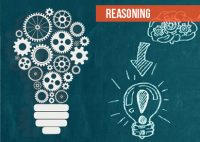Mathematical Operation For SBI PO Set – 4

Mathematical Operation For SBI PO Set – 4
1. Statements:
K ≤ L < M > N ≥ O; T > M ≤ P
Conclusions:
I. T > K
II. P > O
a)If only conclusion I is true
b)If only conclusion II is true
c)If either conclusion I or II is true
d)If neither conclusion I nor II is true
e)If both conclusion I and II are true
2.Statements:
E > F ≥ G < H ≤ I < J
Conclusions:
G ≤ E
J ≥ F
a)If only conclusion I is true
b)If only conclusion II is true
c)If either conclusion I or II is true
d)If neither conclusion I nor II is true
e)If both conclusion I and II are true
3. Statements:
B > C= D ≥ X; E ≤ X; Z ≥ D
Conclusions:
B > E
Z ≥ B
a) If only conclusion I is true
b) If only conclusion II is true
c) If either conclusion I or II is true
d) If neither conclusion I nor II is true
e) If both conclusion I and II are true
4. If ‘÷’ means ‘x’, ‘x’ means ‘+’, ‘+’ means ‘-’ , ‘-’ means ‘÷’ then,
a)– 72
b)- 69
c)– 79
d)- 88
5.Some equations have been solved on the basis of a certain pattern. Find the correct answer for the unsolved equation in the basic.
a)8436
b)2184
c)3180
d)2526
6) In the following questions, the symbols @, ©, $, % and # are used with the following meaning as illustrated below:
‘P$Q’ means ‘P is not greater than Q’
‘P@Q’ means ‘P is neither smaller than nor equal to Q’
‘P#Q’ means ‘P is not smaller than Q’
‘P©Q’ means ‘P is neither greater nor equal to Q’
‘P%Q’ means ‘P is neither smaller nor greater than Q’
Statements:
B%J, J@K, K©T, T©F
Conclusions:
I) F@K
II) B@K
III) B@F
a) I and II are true
b) I and III are true
c) II and III are true
d) All are true
e) None is true
7) In the following questions, the symbols @, ©, $, % and # are used with the following meaning as illustrated below:
‘P$Q’ means ‘P is not greater than Q’
‘P@Q’ means ‘P is neither smaller than nor equal to Q’
‘P#Q’ means ‘P is not smaller than Q’
‘P©Q’ means ‘P is neither greater nor equal to Q’
‘P%Q’ means ‘P is neither smaller nor greater than Q’
Statements:
H$M, M#T, T@D, D©R
Conclusions:
I) D©M
II) R@M
III) H$T
a) None is true
b) Only I is true
c) Only II is true
d) Only III is true
e) All I, II, III are true
8) In the following questions, the symbols @, ©, $, % and # are used with the following meaning as illustrated below:
‘P$Q’ means ‘P is not greater than Q’
‘P@Q’ means ‘P is neither smaller than nor equal to Q’
‘P#Q’ means ‘P is not smaller than Q’
‘P©Q’ means ‘P is neither greater nor equal to Q’
‘P%Q’ means ‘P is neither smaller nor greater than Q’
Statements:
W©B, B%V, V$R, R@K
Conclusions:
I) K©B
II) R#B
III) V@W
a) I and II are true
b) I and III are true
c) II and III are true
d) All I, II and III are true
e) None is true
9) In the following questions, the symbols @, ©, $, % and # are used with the following meaning as illustrated below:
‘P$Q’ means ‘P is not greater than Q’
‘P@Q’ means ‘P is neither smaller than nor equal to Q’
‘P#Q’ means ‘P is not smaller than Q’
‘P©Q’ means ‘P is neither greater nor equal to Q’
‘P%Q’ means ‘P is neither smaller nor greater than Q’
Statements:
R@N, N©D, D$J, J#B
Conclusions:
I) R@J
II) J@N
III) B@D
a) None is true
b) Only I is true
c) Only II is true
d) Only II and III are true
10) In the following questions, the symbols @, ©, $, % and # are used with the following meaning as illustrated below:
‘P$Q’ means ‘P is not greater than Q’
‘P@Q’ means ‘P is neither smaller than nor equal to Q’
‘P#Q’ means ‘P is not smaller than Q’
‘P©Q’ means ‘P is neither greater nor equal to Q’
‘P%Q’ means ‘P is neither smaller nor greater than Q’
Statements:
D#K, K@T, T$M, M%J
Conclusions:
I) J@T
II) J%T
III) D@T
a) Only I is true
b) Only II is true
c) Either I or II is true
d) Either I or II and III are true
e) None is true


